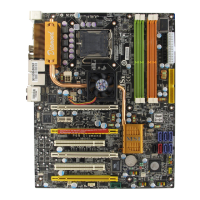3-22
MS-7320 Mainboard
1.If you do not have any EMI problem, leave the setting at [Disabled] for
optimal system stability and performance. But if you are plagued by EMI,
select the value of Spread Spectrum for EMI reduction.
2.The greater the Spread Spectrum value is, the greater the EMI is reduced,
and the system will become less stable. For the most suitable Spread
Spectrum value, please consult your local EMI regulation.
3.Remember to disable Spread Spectrum if you are overclocking because
even a slight jitter can introduce a temporary boost in clock speed which
may just cause your overclocked processor to lock up.
Important
is required to guarantee that data in the write buffers can be written to the
memory cells before precharge occurs.
TWTR
When the Memory Timings is set to [Manual], the field is adjustable. This item
controls the Write Data In to Read Command Delay memory timing. This consti-
tutes the minimum number of clock cycles that must occur between the last
valid write operation and the next read command to the same internal bank of
the DDR device.
TREF
When the Memory Timings is set to [Manual], the field is adjustable. Specifies
the refresh rate of the DIMM requiring the most frequent refresh.
Adjust PCI-E Frequency
This field allows you to select the PCIE frequency (in MHz).
CPU Voltage
This item allows you to increase the CPU voltage.
Memory Voltage
Adjusting the memory voltage can increase the DDR speed.
NB Voltage
Adjust the North Bridge chipset voltage.
SB Voltage
Adjust the South Bridge voltage.
FSB VTT Voltage
This item allows you to set the FSB VTT voltage.
Spread Spectrum
This setting is used to enable or disable the Spread Spectrum feature. When
overclocking, always set it to [Disabled].

